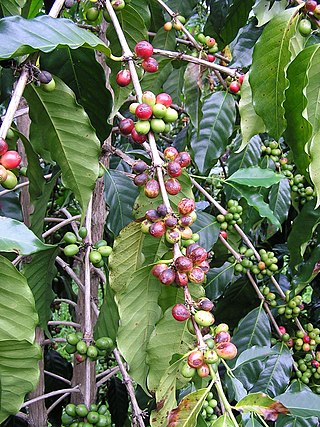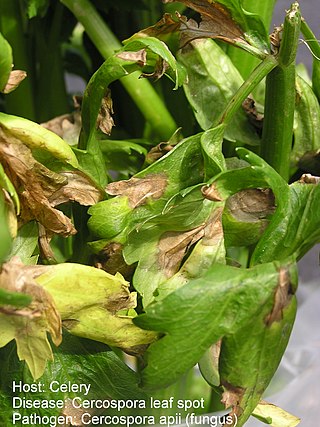| Cercospora corylina | |
|---|---|
| Scientific classification | |
| Kingdom: | Fungi |
| Division: | Ascomycota |
| Class: | Dothideomycetes |
| Order: | Capnodiales |
| Family: | Mycosphaerellaceae |
| Genus: | Cercospora |
| Species: | C. corylina |
| Binomial name | |
| Cercospora corylina W.W. Ray, (1941) | |
| Cercospora corylina | |
|---|---|
| Scientific classification | |
| Kingdom: | Fungi |
| Division: | Ascomycota |
| Class: | Dothideomycetes |
| Order: | Capnodiales |
| Family: | Mycosphaerellaceae |
| Genus: | Cercospora |
| Species: | C. corylina |
| Binomial name | |
| Cercospora corylina W.W. Ray, (1941) | |

Cercospora is a genus of ascomycete fungi. Most species have no known sexual stage, and when the sexual stage is identified, it is in the genus Mycosphaerella. Most species of this genus cause plant diseases, and form leaf spots. It is a relatively well-studied genus of fungi, but there are countless species not yet described, and there is still much to learn about the best-known of the species.

Mycosphaerella coffeicola is a sexually reproducing fungal plant pathogen. It is most commonly referred to as the asexual organism Cercospora coffeicola.
Cercospora apii f.sp. clerodendri is a fungal plant pathogen.

Cercospora beticola is a fungal plant pathogen which typically infects plants of the genus Beta, within the family of Chenopodiaceae. It is the cause of Cercospora leaf spot disease in sugar beets, spinach and swiss chard. Of these hosts, Cercospora leaf spot is the most economically impactful in sugar beets. Cercospora beticola is a deuteromycete fungus that reproduces using conidia. There is no teleomorph stage. C. beticola is a necrotrophic fungus that uses phytotoxins specifically Cercospora beticola toxin (CBT) to kill infected plants. CBT causes the leaf spot symptom and prevents root formation. Yield losses from Cercospora leaf spot are around 20 percent.
Cercospora fragariae is a fungal plant pathogen.
Cercospora fusimaculans is a fungal plant pathogen.

Cercospora handelii is a fungal plant pathogen.
Cercospora platanicola is a fungal plant pathogen.
Cercospora rosicola is a fungal plant pathogen mostly found on plants in the United States, specifically within the state of Texas. The fungi mostly affects roses, and in severe infections can cause defoliation.
Cercospora solani is a fungal plant pathogen.
Cercospora sorghi is a fungal plant pathogen.
Mycosphaerella cruenta, also called Pseudocercosopora cruenta in its asexual stage, is a fungal plant pathogen belonging to the group Ascomycota. It can affect several legume plants, including species of Phaseolus, Vigna, Calopogonium, Lablab niger, Mucuna and Stizolobium deeringianum [Mucuna pruriens][2]. It causes cowpea cercospora leaf spot, one of the most widespread and significant plant diseases in Africa and Asia. A city in China reported a 100% Mycosphaerella cruenta infection rate on cowpea in 2014[5]. In Africa, an epidemic can cause a yield loss of up to 40% [3].
Sphaerulina oryzina is a fungal plant pathogen infecting rice. Propiconazole is an effective fungicide recommended for use in rice culture.
Cercospora rhapidicola is a fungal plant pathogen.
Cercospora hayi is a fungal plant pathogen. It can cause the brown spot disease in bananas.
Cercospora liquidambaris is a fungal plant pathogen.

Cercospora apii is a fungal plant pathogen, who causes leaf spot on celery, and found on other plants, including Impatiens. Since the genus Cercospora is one of the largest and most heterogeneous genera of hyphomycetes, numerous species described from diverse hosts and locations are morphologically indistinguishable from C. apii and subsequently are referred to as C. apii sensu lato.
Cercospora apiicola is a fungal plant pathogen, who causes leaf spot on celery.

Grey leaf spot (GLS) is a foliar fungal disease that affects maize, also known as corn. GLS is considered one of the most significant yield-limiting diseases of corn worldwide. There are two fungal pathogens that cause GLS: Cercospora zeae-maydis and Cercospora zeina. Symptoms seen on corn include leaf lesions, discoloration (chlorosis), and foliar blight. Distinct symptoms of GLS are rectangular, brown to gray necrotic lesions that run parallel to the leaf, spanning the spaces between the secondary leaf veins. The fungus survives in the debris of topsoil and infects healthy crops via asexual spores called conidia. Environmental conditions that best suit infection and growth include moist, humid, and warm climates. Poor airflow, low sunlight, overcrowding, improper soil nutrient and irrigation management, and poor soil drainage can all contribute to the propagation of the disease. Management techniques include crop resistance, crop rotation, residue management, use of fungicides, and weed control. The purpose of disease management is to prevent the amount of secondary disease cycles as well as to protect leaf area from damage prior to grain formation. Corn grey leaf spot is an important disease of corn production in the United States, economically significant throughout the Midwest and Mid-Atlantic regions. However, it is also prevalent in Africa, Central America, China, Europe, India, Mexico, the Philippines, northern South America, and Southeast Asia. The teleomorph of Cercospora zeae-maydis is assumed to be Mycosphaerella sp.
{{cite web}}: CS1 maint: url-status (link)